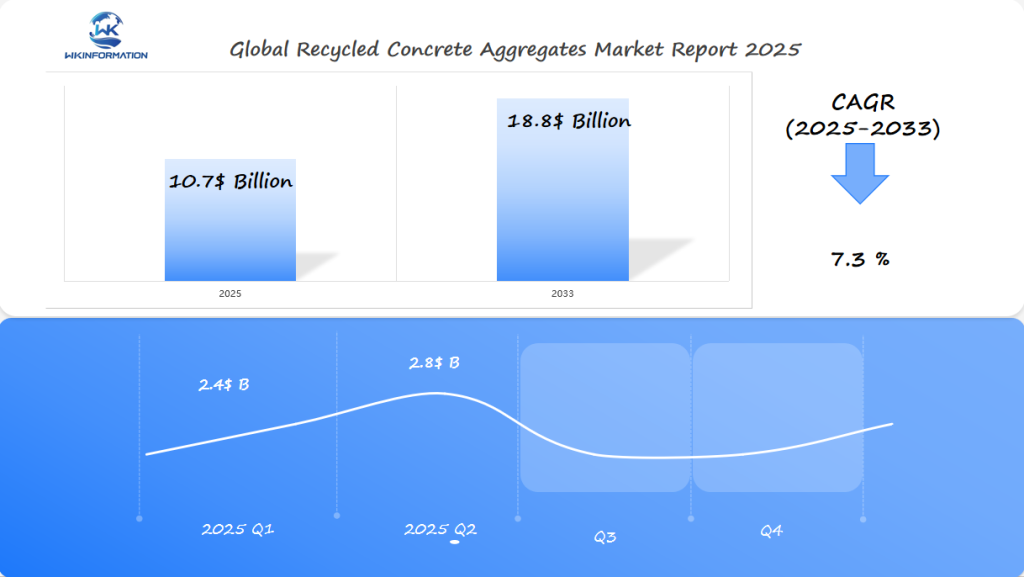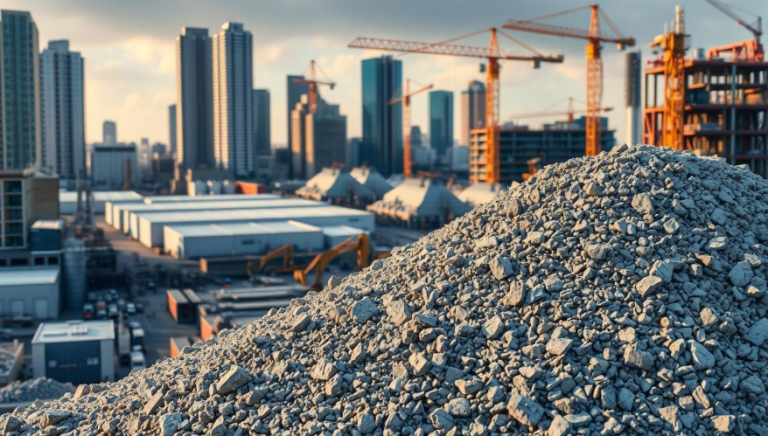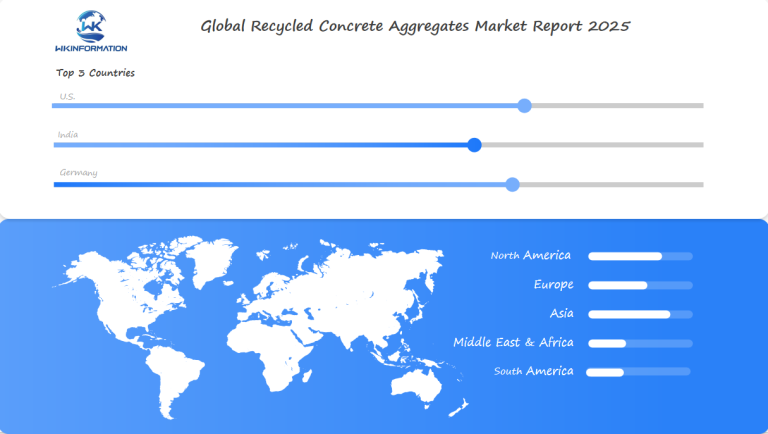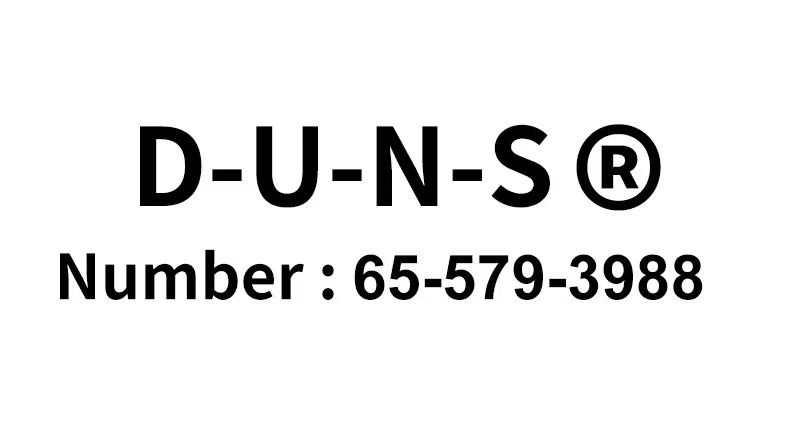Recycled Concrete Aggregates Market Set to Exceed $10.7 Billion by 2025: Growth Drivers from the U.S., India, and Germany
Discover key growth drivers fueling the Recycled Concrete Aggregates Market expansion in the U.S. construction sector, with sustainability and cost benefits leading industry transformation.
- Last Updated:
Recycled Concrete Aggregates Market Outlook for Q1 and Q2 of 2025
The Recycled Concrete Aggregates market is expected to reach $10.7 billion by the end of 2025, with a CAGR of 7.3% from 2025 to 2033. In Q1 of 2025, the market size is projected to be $2.4 billion, driven by a strong push for sustainable building practices and the growing use of recycled materials in construction projects. By Q2, the market is anticipated to increase to $2.8 billion, as demand for recycled concrete aggregates rises with the construction of green buildings and infrastructure projects.

Key Takeaways
- The recycled concrete aggregates market is projected to exceed $10.7 billion by 2025.
- Sustainable construction practices are driving market expansion.
- Material recycling is leading to a significant reduction in construction waste.
- There is a growing environmental awareness in the construction sector.
- Economic incentives for using recycled materials are on the rise.
Understanding the Upstream and Downstream Factors in the Recycled Concrete Aggregates Market
The recycled concrete aggregates (RCA) market is key to both sustainability and construction innovation. It shows how material sourcing, processing, and demand are all connected.
The RCA supply chain has many important steps. It turns construction waste into useful materials:
- Demolition and deconstruction of existing structures
- Collection and transportation of concrete waste
- Processing and quality assessment of recycled materials
- Distribution to construction sites and infrastructure projects
Supply Chain Dynamics
Managing the RCA supply chain well needs good logistics and advanced tech. More construction pros see the value of using recycled concrete. Local processing helps cut costs and reduce carbon emissions.
Demand Drivers
The circular economy is changing how we want sustainable materials in construction. Key factors include:
- Growing environmental rules
- Less money for landfills
- Lower costs for materials
- Better green credentials
As cities grow, so does the RCA market. It offers new ways to build with care for resources.
Trends Shaping the Recycled Concrete Aggregates Industry in 2025
The recycled concrete aggregates (RCA) industry is at a key point. It’s where tech meets green goals. As people care more about the planet, RCA is changing how we build in the U.S.
New recycling tech is changing how we use construction materials. New methods are making recycled concrete better and stronger.
Technological Advancements
New ways to make RCA have made it much better. Some big tech changes include:
- Advanced sorting and screening technologies
- Sophisticated crushing mechanisms
- AI-powered quality control systems
- Sophisticated material characterization techniques
Regulatory Landscape
Green building rules are getting tougher, making RCA more important. The Infrastructure Investment and Jobs Act of 2021 has helped a lot. It provided significant funding for projects that use sustainable materials.
Some major changes in regulations include:
- Stricter environmental performance standards
- Incentives for sustainable construction practices
- Mandatory recycled material usage in public projects
- Enhanced certification requirements for green building
These changes indicate a promising future for RCA. The industry is expected to experience substantial growth and innovative concepts by 2025.
Barriers to Market Growth in the Recycled Concrete Aggregates Sector
The recycled concrete aggregates (RCA) market has big challenges. These stop it from being used more in building projects. Even though it’s good for the environment, many barriers slow down its growth.
Building experts face many hurdles when thinking about using RCA. The main problems are quality worries and old beliefs in the industry.
Quality Concerns in RCA Implementation
People in the construction industry have significant concerns about the quality of RCA (Recycled Concrete Aggregate) used in their projects. The primary issues they face include:
- Variability in material composition
- Potential contamination from previous construction materials
- Inconsistent mechanical properties
- Limited standardization in testing protocols
Market Perception and Adoption Barriers
The construction industry is slow to adopt RCA. Builders and engineers are hesitant because of:
- Uncertainty about how well it lasts
- Not enough clear guidelines
- Concerns about higher upkeep costs
- Not knowing enough about its technical abilities
Research groups and industry leaders are working hard to solve these problems. They aim to improve RCA quality, study its performance, and teach builders more.
As green building gets more popular, the RCA market is ready for big changes. Fixing quality issues and changing how people see RCA is key to its success.

Geopolitical and Economic Impacts on the Recycled Concrete Aggregates Market
The recycled concrete aggregates (RCA) market is shaped by global economic forces and sustainability policies. It shows how geopolitical events affect the development of construction materials.
Global construction trends vary in how they use RCA. Local economic conditions greatly influence the use and growth of recycled construction materials.
Global Trade Dynamics
RCA market economics are mostly local, with unique features:
- 90% of aggregates consumed within 50 miles of extraction point
- Imports and exports represent approximately 1% of total consumption
- Regional sustainability policies dramatically influence market development
Economic Factors
Economic cycles have a big impact on the recycled concrete aggregates sector. Things like infrastructure investment, construction activity, and environmental regulations shape the market.
| Economic Factor | Impact on RCA Market |
| Infrastructure Investment | Drives demand for sustainable construction materials |
| Sustainability Policies | Encourages circular economy practices |
| Construction Sector Growth | Increases potential for RCA adoption |
Investments in recycled concrete technologies show a commitment to the environment and economic growth worldwide.
Recycled Concrete Aggregates Market Segmentation: Materials, Styles, and Usage
The recycled concrete aggregates market is key to green building. It looks at different types of aggregates, how they’re made, and how they’re used. This turns old materials into something new and useful.
Now, old construction and demolition waste is turned into new materials. These materials go through special steps to become top-notch recycled concrete aggregates. They’re perfect for many building projects.
Types of Recycled Concrete Aggregates
- Crushed concrete debris
- Reclaimed asphalt pavement (RAP)
- Mixed demolition materials
- Structural concrete remnants
Each type of aggregate has its own special traits. How good and consistent they are decides if they can be used a lot.
Processing Methods and Quality Control
| Processing Stage | Key Activities | Quality Metrics |
| Sorting | Material separation | Contamination levels |
| Crushing | Size reduction | Particle uniformity |
| Screening | Particle grading | Gradation compliance |
End-Use Applications in Construction
Recycled concrete aggregates are used in many ways in building. They’re used for:
- Road base and subbase layers
- Structural concrete production
- Landscaping materials
- Drainage systems
Thanks to advanced methods, these aggregates meet strict engineering standards. This makes them more widely used in green building.
Applications Driving Demand for Recycled Concrete Aggregates Solutions
The construction world is changing fast, moving towards sustainable materials. Recycled concrete aggregates are key for building better infrastructure. The Infrastructure Investment and Jobs Act of 2021 has opened up big chances for recycled construction materials. This is especially true for highways, streets, and bridges in the U.S.
Big projects are now focusing on sustainable building. This means using green techniques that are good for the planet and strong. Cities and state transportation groups see the benefits of using recycled concrete in big projects.
Home and business builders are also getting on board. They’re using recycled concrete in their designs to meet green standards. This shows they care about the planet and can save money too.
There are many reasons for this shift towards green building. Rules to protect the environment, companies wanting to be sustainable, and people wanting eco-friendly homes are all playing a part. As the building world keeps changing, recycled concrete will be crucial for making stronger, greener buildings across the country.
Global Recycled Concrete Aggregates Market: Regional Insights and Key Drivers
The global RCA market is changing, with different parts of the world showing their own ways. Each area has its own take on international sustainability initiatives. This leads to new ideas in recycled construction materials.
How regions build affects the use and growth of recycled concrete aggregates (RCA). More and more places are seeing the value of green building.
Looking at the global RCA market, we see big differences in how regions approach it:
- North American markets focus on environmental rules
- Europe is a leader in the circular economy
- Asia-Pacific is growing fast in building projects
North American Market Dynamics
The North American RCA market is growing fast, especially in Texas, California, and Florida. These states are major players in the aggregates industry and are showing a strong commitment to sustainable construction practices.
European Leadership in Sustainability
European countries are leading the way in using RCA. Innovative circular economy policies and strict environmental laws are helping the market grow throughout the continent.
Asia-Pacific: Emerging Opportunities
Asia-Pacific is growing fast, with lots of new buildings and roads. Countries like China and India are putting money into green building tech.
The global RCA market is a mix of regional trends and green efforts. It promises more growth and new ideas.

The U.S. Recycled Concrete Aggregates Market: Sustainable Construction Practices
The U.S. RCA market is changing fast. It’s moving towards green building and infrastructure. This change is thanks to caring for the environment and new policies.
The way we build is changing a lot. There’s a lot of money going into using sustainable materials. The Infrastructure Investment and Jobs Act has given a big boost to recycled concrete aggregates in building projects.
LEED Certification and Green Building Standards
LEED certification is key for green building. Builders and developers see the value of recycled concrete aggregates. It helps them get green building credits.
- Reduces construction waste
- Minimizes environmental impact
- Lowers carbon footprint
- Enhances project sustainability ratings
State-Level Recycling Initiatives
States are starting strong recycling programs. These programs help grow the U.S. RCA market.
States like California, New York, and Texas are leading the way. They have plans to make building greener. These plans help the economy and the environment by using the circular economy in building.
As we focus more on being green, recycled concrete aggregates will be more important. They will help shape America’s buildings and roads.
India's Role in Recycled Concrete Aggregates: Urbanization and Infrastructure Demand
The India RCA market is at a turning point. It’s driven by fast urban growth and the need for more infrastructure. India is becoming a major force in using recycled concrete aggregates (RCA).
Building cities in India comes with its own set of challenges and chances for RCA. The country needs new ways to build while caring for the environment.
Urban Development Projects Driving RCA Adoption
- Smart city plans lead to more infrastructure spending
- There’s a big need for green building materials
- Less waste in construction is a big plus
Cities like Mumbai, Delhi, and Bangalore are growing fast. These cities are key places to test RCA in developing markets.
Challenges and Strategic Opportunities
| Challenge | Potential Solution |
| Quality Control | Advanced testing and certification protocols |
| Market Awareness | Technical training and demonstration projects |
| Regulatory Framework | Government incentives for sustainable construction |
The India RCA market is full of hope for green city building. Investing in tech, training workers, and good policies can help RCA grow in India’s building projects.
Germany's Influence on the Recycled Concrete Aggregates Market: Regulation and Innovation
Germany leads in sustainable construction, changing the global recycled concrete aggregates (RCA) market. It’s known for its green efforts, making it a top name in construction technology. The country’s focus on the environment has led to new ways to manage waste and save resources.
The German RCA market shows the latest in green building. Their strategy includes:
- Stringent European recycling standards implementation
- Advanced technological research in concrete recycling
- Comprehensive circular economy policies
- Robust waste management frameworks
Circular Economy Policies
Germany’s circular economy changes how it handles construction waste. It has strict rules to make waste management better. These policies help recycle concrete materials fully, using all construction and demolition waste.
Technological Leadership
German engineers and researchers continue to enhance construction technology. They employ cutting-edge techniques to produce top-notch recycled concrete aggregates. The German RCA market is renowned for transforming demolition waste into valuable building resources.
Germany remains committed to investing in research and development. It plays a crucial role in eco-friendly construction, influencing global practices in concrete recycling and environmental conservation.
Future Outlook for the Recycled Concrete Aggregates Market
The recycled concrete aggregates (RCA) market is set for big changes. New technologies and green building trends will lead the way. Experts say we can expect a big growth in how we build and protect our environment.
The RCA market is expected to grow a lot. This growth is thanks to new tech and global efforts to be green.
Emerging Technologies Transforming RCA
New tech is changing the recycled construction materials market for the better. AI and smart sorting systems are making things more efficient and better quality.
- AI-powered material sorting technologies
- Advanced crushing and processing equipment
- Digital tracking and quality control systems
Market Projections and Growth Indicators
The future of green building looks bright. Many signs point to a big increase in the market. More and more projects are using recycled materials.
Investing in research and development is key for companies to succeed in the RCA market. Using the latest tech and focusing on sustainability will be crucial for success.
Competitive Landscape of the Recycled Concrete Aggregates Market
Key players in the recycled concrete aggregates market are focusing on technological advancements to improve material quality and sustainability. They are expanding operations in emerging regions such as Asia-Pacific and the Middle East to meet the growing demand for eco-friendly construction materials. Strategic collaborations with construction firms and investments in recycling infrastructure are enabling these companies to enhance their market presence and drive industry growth.
Key Players:
-
LafargeHolcim (Switzerland)
-
CEMEX (Mexico)
-
HeidelbergCement (Germany)
-
Vulcan Materials Company (USA)
-
CRH (Ireland)
-
Boral (Australia)
-
Aggregate Industries (UK)
-
Lehigh Hanson (USA)
-
Tarmac (UK)
-
Holcim (Switzerland)
Overall
| Report Metric | Details |
|---|---|
| Report Name | Global Recycled Concrete Aggregates Market Report |
| Base Year | 2024 |
| Segment by Type |
· Crushed concrete debris · Reclaimed asphalt pavement (RAP) · Mixed demolition materials · Structural concrete remnants |
|
Segment by Application |
· Road base and subbase layers · Structural concrete production · Landscaping materials · Drainage systems |
|
Geographies Covered |
· North America (United States, Canada) · Europe (Germany, France, UK, Italy, Russia) · Asia-Pacific (China, Japan, South Korea, Taiwan) · Southeast Asia (India) · Latin America (Mexico, Brazil) |
| Forecast units | USD million in value |
| Report coverage | Revenue and volume forecast, company share, competitive landscape, growth factors and trends |
Global Recycled Concrete Aggregates Market Report (Can Read by Free sample) – Table of Contents
Chapter 1: Recycled Concrete Aggregates Market Analysis Overview
- Competitive Forces Analysis (Porter’s Five Forces)
- Strategic Growth Assessment (Ansoff Matrix)
- Industry Value Chain Insights
- Regional Trends and Key Market Drivers
- Recycled Concrete Aggregates Market Segmentation Overview
Chapter 2: Competitive Landscape
- Global Recycled Concrete Aggregates Players and Regional Insights
- Key Players and Market Share Analysis
- Sales Trends of Leading Companies
- Year-on-Year Performance Insights
- Competitive Strategies and Market Positioning
- Key Differentiators and Strategic Moves
Chapter 3: Recycled Concrete Aggregates Market Segmentation Analysis
- Key Data and Visual Insights
- Trends, Growth Rates, and Drivers
- Segment Dynamics and Insights
- Detailed Market Analysis by Segment
Chapter 4: Regional Market Performance
- Consumer Trends by Region
- Historical Data and Growth Forecasts
- Regional Growth Factors
- Economic, Demographic, and Technological Impacts
- Challenges and Opportunities in Key Regions
- Regional Trends and Market Shifts
- Key Cities and High-Demand Areas
Chapter 5: Recycled Concrete Aggregates Emerging and Untapped Markets
- Growth Potential in Secondary Regions
- Trends, Challenges, and Opportunities
Chapter 6: Product and Application Segmentation
- Product Types and Innovation Trends
- Application-Based Market Insights
Chapter 7: Recycled Concrete Aggregates Consumer Insights
- Demographics and Buying Behaviors
- TargetAudience Profiles
Chapter 8: Key Findings and Recommendations
- Summary of Recycled Concrete Aggregates Market Insights
- Actionable Recommendations for Stakeholders

Access the study in MULTIPLEFORMATS
Didn’t find what you’re looking for?
TALK TO OUR ANALYST TEAM
Need something within your budget?
NO WORRIES! WE GOT YOU COVERED!
Call us on: +1-866-739-3133
Email: infor@wkinformation.com
What are Recycled Concrete Aggregates (RCA)?
Recycled Concrete Aggregates are made by crushing old concrete. They can be used in new construction projects as an environmentally friendly alternative to traditional aggregates.
How large is the Recycled Concrete Aggregates market expected to grow by 2025?
The market for RCA is set to grow past $10.7 billion by 2025. This growth is thanks to more green projects and building up infrastructure worldwide.
What are the primary benefits of using Recycled Concrete Aggregates?
Using RCAs helps the planet by cutting down on landfill waste and lowering carbon emissions. It also saves natural resources and can make building cheaper.
How do Recycled Concrete Aggregates compare to natural aggregates in quality?
RCAs used to be seen as lower quality. But new technology and better ways of processing have made them just as good as natural rocks for many uses.
Which countries are leading in Recycled Concrete Aggregates adoption?
Countries like Germany, the United States, and many in Europe are leading in using RCAs. They have good rules and the latest recycling tech.
What construction applications are most suitable for Recycled Concrete Aggregates?
RCAs work well for:
- Roads
- Bridges
- Building foundations
- Landscaping
- Other civil projects
They’re versatile and strong.
How does the Infrastructure Investment and Jobs Act impact RCA usage?
The Act will likely increase demand for RCAs. It supports green building and encourages using recycled materials in public projects.
What challenges exist in widespread RCA adoption?
Challenges include changing how people see RCAs, quality issues, and not knowing enough about them. Also, making sure recycling is done right is key.
How do green building standards influence RCA market growth?
Green standards like LEED push builders to use sustainable materials like RCAs. This helps the market grow and supports the idea of a circular economy.
What technological innovations are emerging in concrete recycling?
New tech includes AI for sorting, better crushing tools, and ways to test and process materials. These advancements improve RCA quality and use.


